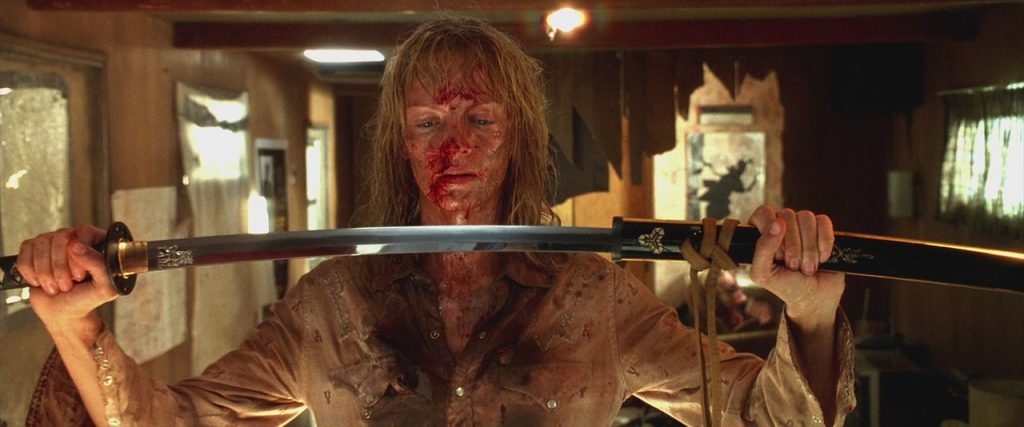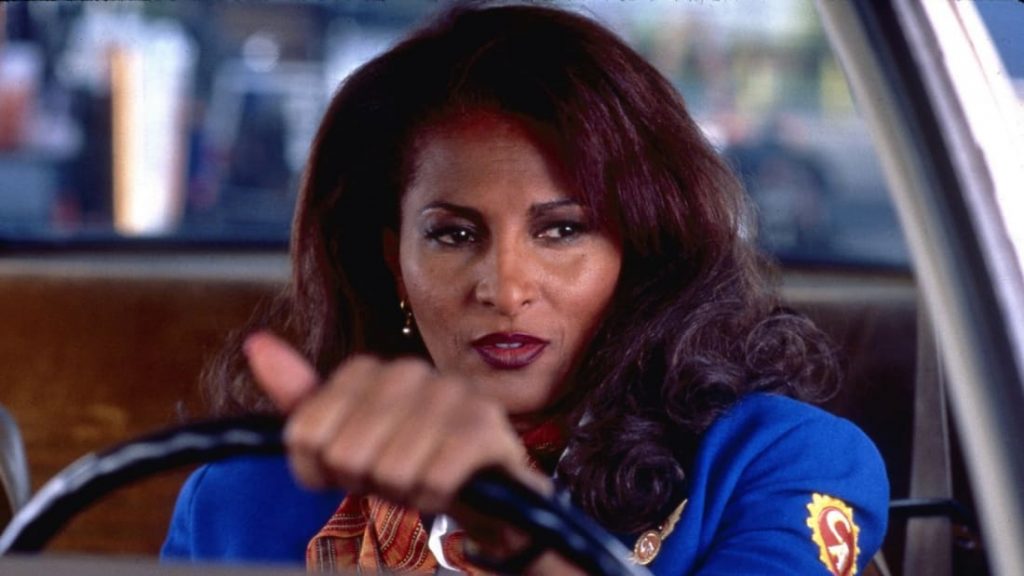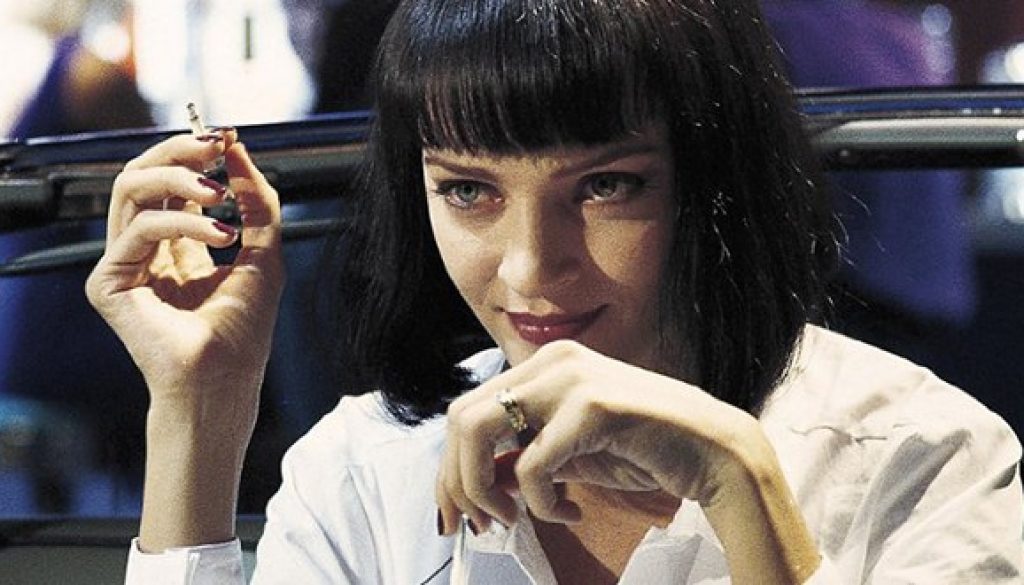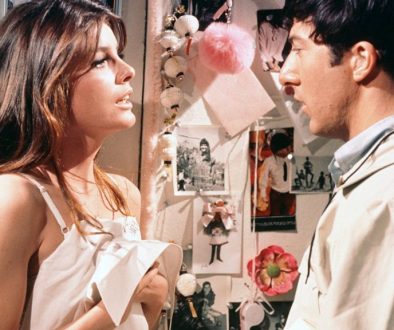The Role of Female Characters in Quentin Tarantino’s Oeuvre
The onetime video clerk, lover of female protagonists and independent cinema redefiner. Quentin Tarantino is certainly a rarity in popular cinema. Over his 25 plus years in the industry, Tarantino has ushered in a new era of tough female characters into major motion pictures; they control the narrative, dominate the action and most importantly contribute to his ever-growing auteur status. His complex storytelling, wacky editing and renowned casting have contributed to a divide amongst filmgoers, this being the debate focused on the female characters in his films. His offerings to the medium have raised questions; are his films empowering to women, offering strong aspiration figures to spectators? Or are the graphic depictions of violence involving women fetishised, exhibiting an insight into Tarantino’s ideal women?
Tarantino’s oeuvre pays homage to a diverse range of styles and genres, (including westerns, film noir and Japanese cinema) with most of these influences treating women as an inferior character. Despite this, in his films both sets of genders are reasonably flawed characters who deal with relatable issues, whilst still, tough personalities. However, there is a constant underlying theme in his films which defines his work and heavily contributes to his almost-feminist stance, this being the motif of revenge present amongst his female characters.
The craving for revenge, which transforms his woman from a ‘passive’ (weak) character, into an ‘active’ (strong) character is his backbone of the progression of his characters. Much like Martin Scorsese, with his view on gender, sexual politics and general perception of female characters are too viewed as his backbone in his auteur making. Though in stating this, on the contrary with Tarantino, Scorsese’s underlying masculinity theme and the general male dominance are heavily portrayed in his films, which is very un-Tarantino. Scorsese’s men are violent towards women, as shown in the cases of Jake LaMotta’s wife, Vickie LaMotta in Raging Bull (Scorsese, 1980) and with Henry and Karen in GoodFellas (Scorsese, 1990). Tarantino portrays the opposite of this, whereas Scorsese’s perception of his women are depicted in less-significant, submissive state compared to those of his men. They are characterised as weak, inferior characters in comparison, whose only purpose in the narrative is to be told by their husbands what to do.

Tarantino prefers to illustrate his women in a strong light who control the narrative, and are arguably stronger than his men. It is this evolution amongst female characters frequently depicted in his films, which makes Tarantino unique and in doing-so makes him one of a few popular cinema writer-directors to-do this regularly and successfully. Much how Anne Billson observes, Tarantino’s roles for female characters ‘have been getting stronger,’ which as she states, makes Tarantino a ‘rare director’ (Billson, 2009). In this essay, I will be examining Tarantino’s female characters in some selected films from his oeuvre, in doing- so addressing whether he has been successful in developing and extending the range of ways in which females can be represented on screen in popular cinema.
The evolution of Tarantino’s women is a fascinating concept. Throughout his career, his female characters become actively more involved with the narrative in each passing film. In examining Tarantino’s filmography, female characters are ever-present as one of the main protagonists in the majority of his films and are continuously evolving. The only stipulation amongst his oeuvre is his debut film, Reservoir Dogs (Tarantino, 1992) a heist- gone-wrong film which predominately focuses on the male characters. It features one woman in the entire narrative, who shoots Mr. Orange before being shot-and-killed herself, a few seconds afterwards. The film discusses women at length, defined within the first few minutes of the opening scene, as the recently formed gang discuss Madonna’s ‘Like a Virgin’ and Mr. Pink’s tirade on the tipping of waitresses. However, as Hooks observes, in Tarantino’s oeuvre she believe women liberations is ‘just another scam,’ (Hooks, 2008) as women in this film are mostly ghostly figures and have no stance in the film. Whilst I do mostly agree with this statement in reference to Reservoir Dogs, arguably the one woman’s actions change the narrative and instigate a homoerotic relationship between Mr. Orange and Mr. White over Orange’s potential death.
It is not until Tarantino’s second feature, his academy award winning script Pulp Fiction (Tarantino, 1994), that spectators are properly introduced to a female character; the mysterious Mia Wallace, played by Uma Thurman, is who came to fruition. Though compared to his later films, Mia’s defining presence in the narrative is somewhat insubstantial, as she is known as ‘Marcellus Wallace’s wife’ and is only seen in conduction with Vincent Vega. Her intellect and mysterious personality atone for this, intriguing the spectator and Vincent.
The use of her sexuality furthers emphasises this mysterious element, but rather than in a characteristic one-dimension sense like in Tarantino’s influences, Mia utilises her sexuality as a facade to silently control Vincent. A close-up of Mia’s bright red lips displays this and draws in the attention of the spectator, as the shot focuses on this for a few seconds, establishing Mia’s sexuality. With the connotations associated with the colour of red; power, lust and danger, these words describe Mia’s character within the first few seconds of her introduction.

Yet in Tarantino portrayal of Mia he exhibits a flawed character, in-keeping with relate-ability for the spectator. This is shown through her cocaine addiction; by inducing a drug overdose and nearly killing her, only for then Mia needing to be rescued by Vincent. As a result of this, Mia is denied a voice in the narrative after her near-death experience, whereas in-comparison, Beatrix Kiddo refuses to be held back or easily characterised in Tarantino’s Kill Bill: Vol.1 and Vol.2 (2003 and 2004, Tarantino). This is demonstrated in the opening scene where she is lying down on the floor, badly beaten up and bloody, only to be shot by Bill. Another example is when she is awoken from her coma, discovering the creature that is Buck who is renting her body, or after being buried alive by Budd, digging her way out.
Instead of exiting the narrative, she embarks on a revenge quest to kill the five people involved in destroying her life, as well as anybody in her way. As Barlow observes, from Pulp Fiction onwards Tarantino’s goal has been to change the perception of his female protagonists from stereotypical characters, ‘into a kind of goddess, who could bring themselves back to life’ (Barlow, 2010). Significantly, Beatrix’s themes encompass Tarantino visual of strong women, as she deal with abandonment and motherhood. This is shown through the emotional journey Beatrix undertakes in order to kill Bill and the remaining members of the Deadly Viper Assassination Squad. As a result of this, Tarantino illustrates these films as his ‘feminist statement,’ and ‘film(s) about girl power’ (Johnston, 2003).
As mentioned earlier, Tarantino’s female characters have a craving for revenge, which ultimately transforms them from a ‘passive’ (weak) character, into an ‘active’ (strong) character. Aside from Beatrix, this transformation is also shown by the female antagonist in Vol.1, O-Ren Ishii. Although in the present-time, the depiction of O-Ren is of her serious and cold-blooded personality, but we are shown how in the past she was a victim too. In the animated sequence of her backstory, the animation illustrates the tale of (then) nine- year-old O-Ren witnessing the murder of her parents. Her father murdered by Matsumoto’s right hand henchman, Riki, and the murder of her mother personally executed by Matsumoto himself.
O-Ren transformation into becoming ‘active’ is shown by her seeking revenge for the death of her parents, by murdering Matsumoto as she depicts him through sexual advances. Years later, she had become a top female assassin, as well as undertaking the leadership of Tokyo’s underworld, granting her the title of the ‘Queen of Tokyo’s underworld’ by Beatrix. Ultimately, Beatrix kills O-Ren in a blood-filled fight, but this scene is a testimony to Tarantino’s vision of displaying two equally mentally and physical powerful women in this final battle, who both have transformed from a ‘passive’ (weak) character, into an ‘active’ (strong) character.
Vernita Green, another character who is an equally strong women and her four year old daughter Nikki, who unknowingly interrupts Beatrix’s and Vernita’s fight scene, reintroduce the themes of motherhood to Beatrix since she (thought she) lost her own child in Vol.1. Perhaps Beatrix’s jealously plays a part, as her daughter would have been a similar age. Typically, the spectator expects some form of mercy for Vernita when Beatrix is fight her, as she is a mother, tending the needs of her child. However, we understand from Beatrix’s actions of killing Vernita as Nikki accidentally watches, that Tarantino’s motive of revenge knows no boundaries. Subsequently, Vernita as well as Beatrix both ‘embody both killer and maternal instincts’; highlighting how a women can be both mothers and killers. With this, and Beatrix’s lack of empathy for Vernita and Nikki, Tarantino succeeds in developing the range of ways in which females can be represented on the screen in popular cinema in this film, regardless of how gruesome it is.
Fight scene between female characters dominate the narrative, compared to those involving men. Each ‘battle’ is more physical and challenging than the last, however this could be identified as a result of gender association. When the spectator sees women involved in fighting, it is represented as more violent compared to a fight involving men. As Tarantino explained, ’when you see two beautiful women, and they’re hurting each other […] that hurts, more than with two guys’ (Schubart, 2007). Yet it is Bill’s death which highlights this unprecedented notion of Tarantino’s heroines. Beatrix’s method in killing him, by utilising Pai Mei’s ‘five-point-palm exploding-heart-technique,’ rather than the use of her sexuality. This further highlights how Tarantino has succeeded in his goal of representing women in popular cinema in a different way. Beatrix is shown in a strong and powerful light, by killing the man that ruined her life and took her child away. Because of this Beatrix not only ‘controls the action,’ she defines it (Coulthard, 2007).
Perhaps Beatrix not being identified with one defining name is related to Tarantino’s success in extending the range in-which female characters are represented on the screen. ‘Beatrix’/’Black Mamba’/’The Bride’ which were co-created by Quentin Tarantino and Uma Thurman, or ‘Q’ and ‘U’. Their character is associated with multiple roles in the films. Within Kill Bill, we see a conflict of motherhood and individualism in the character of Beatrix, as she transforms between an assassin travelling all over the world, employed to kill people. At this point she is known as ‘Black Mamba’. Then her priorities shift when becomes pregnant and her motherly instinct taking over, becoming ‘The Bride’. This leaves an unanswered question; does motherhood change her?
Tarantino uses the ‘mother archetype, not as a psychological figure, but as a dramatic device’ (Schubart, 2007) with Beatrix, as the spectator notices her transformation when she discovers her daughter is still alive in Vol.2. In my opinion, she becomes Vernita; caring for her child whilst still using her abilities to protect herself and Nikki. However Beatrix’s circumstances are slightly different. Much like Vernita, she embodies a dual expectation which modern women are placed under, a combination of independence and parenthood. As Davis reiterates, ‘while Beatrix does not meet her daughter until the end of the film, she makes sacrifices for her child through the movie’ (Davis, 2007). In saying this, Beatrix is not married, nor has a life outside her assassin’s ways, unlike Vernita. So when she is introduced to her child, Beatrix epitomises both of these roles and demonstrates them in an un-sexualised way, which is uncommon for female heroines in cinema. Thus, Tarantino succeeds in extending the range of ways in which females can be represented on screen in popular cinema by making Beatrix an inspirational figure.
In playing devil’s advocate, Kill Bill has also been criticised for its sexualisation of women. In a discussion with Ian Hislop on the so-called sexualised nature of the film, he criticises Tarantino for making a film which forces the spectator to watch ‘women suffer’ in ‘rather pervy’ way, in doing-so he ‘get the girls to fight a lot’. Because of this, Hislop states Tarantino gets ‘called a genius because of it’ when he believes he is not, just another Hollywood director (Hislop, I. 2008, YouTube) [Online]. It is Barlow who discusses in his book, how Beatrix does have to ‘flash her feminine attributes through scan outfit, or seductive behaviour’ (Barlow, 2010) to counter her personality. But as referenced earlier, Tarantino illustrates these films as his ‘feminist statement’. Beatrix is fundamentally a strong character, who whether male or female would be considered powerful. Because of this, I cannot help but disagree with Hislop’s comments and agree with Barlow, as female empowerment is at the centre of these films.
Yet it is Tarantino’s Jackie Brown, (1997, Tarantino) in-which he succeeds in firstly creating
a female-led protagonist, and extends the range of representation of women in popular
cinema. Unlike Tarantino’s other female characters, Jackie primary motive is not revenge
or vengeance, she is unique in this sense. Neither is she victimised because of this which
too is rare in popular cinema. Her goal is leading a life of luxury by stealing money from
drug traffickers, far from a personal vendetta. Contrary to Shosanna Dreyfus, Beatrix
Kiddo and the second set of characters in Death Proof (2007, Tarantino) who are all out of
for vengeance because of the trauma suffered by these antagonists.
Unique is a word often associated with Jackie Brown, in comparisons to the rest of Tarantino’s oeuvre. Jackie is not a deadly assassin who has the ability to kill hundreds of other assassins, or a stuntwomen who has the confidence in risking her life on-a-daily basis to earn a pay check. In contrast, Jackie is a regularly person, with a regular job; instead she uses her intelligence to navigate her escape. Succeeding as she escapes with the money and her pride. Additionally, Jackie’s sexuality is not exploited in the film as it has no effect in her escape, which too is rare in popular cinema. As film theorist Laura Mulvey observes in her 1975 essay, ‘Visual Pleasure and Narrative Cinema,’ she argues Popular cinema directors often force spectators to watch their film from a male perspective. Leading spectators to believe women are an object of desire. This is not evident in Jackie Brown, nor in most Tarantino flicks, as Jackie proves to the spectator as a regular women, she can control the narrative and succeed in her objective without using her sexuality. As a result of this, Tarantino reinvents what sexiness can be.

Though in Tarantino’s Death Proof (2007, Tarantino), it could be argued that he is not adhering to own reinvention of the female sexuality, by utilising the male gaze. In his tribute to slasher films, Death Proof the second part of Grindhouse (2007, Tarantino and Rodriguez) series, a twisted action film full of female characters. The film recounts the story of two sets of girls and their encounters with psychopathic killer, ‘Stuntman Mike’ and his death proof car. Critically, this film is torn. The divide, much like marmite, Death Proof is either loved or hated; but then again this sums up Quentin Tarantino oeuvre. There is an ongoing discussion on whether the female characters in this film extend the range in which females can be represented on screen in popular cinema.
Traditionally, slasher films terrorise female characters far more than males; though this is somewhat depicted within Tarantino’s version, it is not entirely true. In ‘Part 1,’ the first set of female characters are, according to Barlow, ‘rather frivolous, dope smoking and drinking’ women, who are somewhat ‘sexually naive’ (Barlow, 2010). This is exemplified when Stuntman Mike talks to Julia, Butterfly, Shanna, and Pam on an objective level in his misogynistic way, attempting to seduce them. Tarantino shoots these women through the ‘male gaze,’ and makes them weaker in comparison to his other female characters. This not only limits the range of ways in which females can be represented on screen in popular cinema, but conforms to female character stereotypes.
For instance, Butterfly’s lap dance in-front of the crowded bar reiterates this notion of her character only being used as a ‘sexual object’ (Mulvery 1989). Though initially she refuses, Mike constant persistence (with the help from Julia) pushes her into unwillingly performing it for him, telling her ‘there’s nothing more beautiful than an angel with a bruised ego’. Simultaneously, Butterfly performing this lap dance could be a considered as a form of female empowerment. Reverting back to an earlier comment, Tarantino is influenced by film noir, and the femme fatale aspect;
Butterfly’s use of her sexuality is an acknowledgement to this, because in film-noir codes and conventions a women use of her sexuality is deemed as powerful. Though Tarantino shoots this scene in an extreme sexualised way, shown through the amount of low angles of Butterfly, sexualisation of her legs and bottom. This too can be viewed as a Tarantino’s celebration to the female gender. Though in saying this, this sexual appeal does not materialise, instead the lap dance signifies Mike’s masculinity and power complex. The use of this scene is to make the spectator uncomfortable, and exhibit the type of character Mike really is. It can also be argued that rather than choosing to perform, she can retain her dignity and the stubbornness she is introduced as having.
As a result of the first set of characters depiction, feminist-led protests were instigated when Tarantino promoted Death Proof in Glasgow and Liverpool. His response, ‘the protests blew my mind, because everywhere else on planet Earth people have been talking about how I made a movie that empowered women’ (Vijay, 2007). Perhaps Tarantino’s comments are somewhat understandable because of his depiction of women in the second segment. Conclusively, the first segment of characters, aside from Julia, does not present of having responsibilities (i.e., jobs) in their life, or have sisterly bond compared to the second set of characters. Though these are a common convention of the genre, the first segment of women certainly have moved Tarantino away from his trope of tough female character in scenes associated with of mayhem.
Comparatively, the women within the second segment are the polar-opposites to those in the first. Again, aside from Julia; Lee, Abernathy, Kim and Zoë are working women (two stuntwomen, makeup artist, and actress), whilst even Abernathy is a mother. Certainly the main difference is their responses to Stuntman Mike’s provocation. As the first set concedes to Mike and are killed multiple times in a dramatic and gruesome fashion, the second set are not and instead retaliate, which is unconventional of the genre. Because of this, Mike is irritated by their confidence as it emasculates him, which results in him attempting to kill them and remove them from the narrative, as he did with the first set.
Mike meets his match with these women. Uncharacteristically, he does not expect them to have a similar skill set to his. Moreover, these girls illustrate the idea of a female character ‘who outsmarts [and] outguesses her assailant’ (Barlow, 2010). Not only does this emasculate Mike, it proves Tarantino is developing and extending the way female characters are presented on scene, as badasses like Beatrix Kiddo.
As Billson discusses, ‘only a director who really likes women could film them like this’ (Billson, 2009), and because of Mike’s arrogance, he is killed by these women. Therefore, does a bigger question need to be answered? As sexual violence is a major trope within slasher/horror films, and a large amount of this sexual violence is aimed at women, does being a strong independent woman in these films mean someone who kills their oppressor? In Tarantino’s mind it does, with his version of the genre differing for the conventional stereotype. Though often female characters are fetishised more than males in popular cinema, in Tarantino’s films the male characters equally fetishised. The gimp scene in Pulp Fiction springs to mind.
As a film, Death Proof exhibits female empowerment in both sets of characters, but more- so in the second set. In this set, the films demonstrates a camaraderie between female characters, which is rare in popular cinema, instead of displaying stereotypical characters which actresses are known for playing for in this genre and in popular cinema in general. Similarly to Beatrix Kiddo and Jackie Brown; Lee, Abernathy, Kim and Zoë display an embodiment of expectation modern women are placed under, a combination of independence, parenthood, intelligence and brawn. As they not only contradict stereotypes ‘women are frail victims’ (Innes, 1998), but do-so in a way which does not devalue them. With this film, Tarantino is attempting to show mainstream spectators how he views female characters, compared to those of traditional slasher stereotypes, as Barlow examines; ‘To see what Tarantino is trying to do, one need only to look at the contrast between the two sets of girls’ (Barlow, 2010).
Tarantino’s writing and directing instigates contrasting opinions through his scenes of constant mayhem, whether through action or dialogue sense. However it is his endings which provoke an emotional stance in his spectators, and preserve this association his female characters have with them. For every film where a female character is dominant in, these characters offers spectators a role model. In his essay, ‘The Auteur Theory,’ Peter Wollen observed how ‘only the lesser auteurs’ are defined by their constant use of ‘basic motifs, which remain […] without variation’ (Wollen, 1972). Only the great directors are defined by the evolution in their work. Tarantino’s female characters define his progression in cinema, and establish his auteur status. Not only are his female characters confident and capable, they control the narrative, which sadly is rare in his influences and popular cinema in general.
Jackie Brown, Beatrix Kiddo and the second set of girls in Death Proof are strong, independent women who each extend the range of ways in which females can be represented on screen in popular cinema. Whether this is through an intellectual sense as seen in Jackie Brown, a strong sense as seen in Kill Bill, or a confident sense as seen in Death Proof. As Tarantino succeeds in this, his female characters do not identify with ‘figures relegated [to] silence’ (Kaplan, 2008), instead they fight back, no matter how in- perfect they are. Tarantino’s women are human, as Billson states, ‘Tarantino […] films actresses so they appeal like real people’ (Billson, 2009), and this makes his women inspirational to the spectator.
List of Reference
Academic:
- – Barlow, A, 2010, ‘Quentin Tarantino: life at the extremes’, Praeger, New York
- – Hooks, B, ‘Cool Cynicism: Pulp Fiction’, Reel to Reel: Race, Class and Sex at the Movies (London: Routledge, 1996), p.60.
- – Davis, A, 2007, ‘Beatrix Kiddo: Popular Culture’s Deadlist Super-mom’, in Dialogues@RU, Vol.6, pp. 14-23
- – Schubart, R (2007) ‘Super Bitches and Action Babes’ (McFarland & Company, Inc., Publishers).
- – Inness, Sherrie A. ‘Tough Girls: Women Warriors and Wonder Women in Popular Culture’. Philadelphia: University of Pennsylvania Press, 1999.
- – Mulvey, L 1989, ‘Visual Pleasure and the Narrative Cinema’, in Film and Theory (eds. Miller, T and Stam, R), Blackwell Publishers, Melbourne, Macmillan, United Kingdom
- – Coulthard, L 2007, ‘Killing Bill: Rethinking Feminism and Film Violence’, in Interrogatin Post-Feminism (eds. Tasker, Y and Negra, D), Duke University Press, United States of America.
- – Kaplan, E 2008, ‘The History of Gender Studies in Cinema’, in Screening Genders (eds. Gabbard, K and Luhr, W), Rutgers University Press, United States of America
- – Wollen, P. (1972). ‘Signs and Meaning in the Cinema’. Bloomington: Indiana University Press. Journals/Online:
- – Johnston, A. (2003). Kill Bill [online] Thefword.org.uk. Available at: <http:// www.thefword.org.uk/reviews/2003/11/kill_bill> [Accessed 29 Apr. 2015].
- – Hislop, I. (2008). Mark Kermode & Ian Hislop trash KILL BILL VOL 1. Available at: <https://www.youtube.com/watch?v=itwMCEJZRCA> [Accessed 28 Apr. 2015].
- – Vijay, A. (2007). Tarantino Takes Liverpool. [online] empireonline.com. Available at: <http://www.empireonline.com/news/story.asp?NID=21054> [Accessed 30 Apr. 2015].
– Billson, A. (2009). Anne Billson: Why Quentin Tarantino should be celebrated by women.
[online]
The Guardian. Available at: http://www.theguardian.com/film/2009/may/29/ tarantino-female-roles [Accessed 26 April 2015].
Filmography
- – Kill Bill Vol.1, Dir. Tarantino, Quentin. 2003. Miramax Films.
- – Kill Bill Vol.2, Dir. Tarantino, Quentin. 2004. Miramax Films.
- – Jackie Brown, Dir. Tarantino, Quentin. 1997. Miramax Films.
- – Pulp Fiction, Dir. Tarantino, Quentin. 1994. Miramax Films.
- – Reservoir Dogs, Dir. Tarantino, Quentin. 1992. Miramax Films.
- – Grindhouse, Dir. Tarantino, Quentin & Rodriguez, Robert. 2007. Troublemaker Studios.
- – Death Proof, Dir. Tarantino, Quentin. 2007. Troublemaker Studios.
- – Raging Bull, Dir. Scorsese, Martin. 1980. United Artists.
- – GoodFellas, Dir. Scorsese, Martin. 1990. Warner Bros. Entertainment


